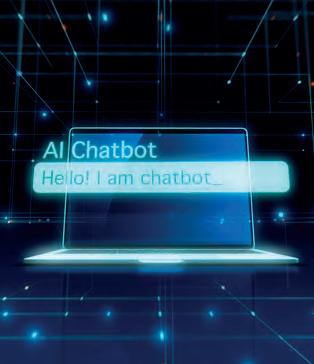
4 minute read
Examining, teaching, and learning in the age of generative AI
A first assessment of the consequences for higher education
by Thomas Bieger and Martin Kolmar
Advertisement
Many educators and managers of IHEs may have undergone a similar experience in December 2022 - often alerted by their teenage kids, they became aware of advances in GAI with the potential to disrupt teaching and examination. A lot has happened since then, as GAI promises to be the “next big thing,” potentially revolutionising everything from (white collar) work to the way we organise information and relate to each other. Although it is not clear at this time exactly what will survive the hype, the potentially far-reaching consequences of this new technology make it necessary for IHEs to develop early strategies for how best to respond to it. Chatbots like ChatGPT or GPT 4 raise the question of how GAI will change or add to the competencies our graduates will need in the future world of work, what pedagogical and didactical formats will be required to teach these competencies, and ultimately how it will affect the overall strategies of IHEs.
How to react to GAI in the classroom?
A typical and intuitive first reaction of educators to new technologies challenging traditional ways of teaching is often to ban them or to constrain their use. One example is the time when calculators became available, but students were still forced to solve math problems by hand. This reaction is flawed. If the goal of education is to prepare students for real (work) life, and if GAI promises to be an essential part of it, we must find ways to integrate it into our programs. IHEs have an obligation to help students develop the necessary skills to use these tools productively— and to understand their limitations, including the associated ethical challenges.
Competencies for the new workplace
IHEs, therefore, need to identify the knowledge, skills, competencies, and attitudes required— and place them at the centre of their curricula, teaching, and examination methods. To do so, three fundamental questions must be addressed:
• First, we need an idea about the impact of GAI on the future of work, how it will change the way industries organise their value chains and create new, changing or even eradicating existing professions in this process. Program managers must reassess the skills and competencies necessary for their students to flourish in their future work life. Humans cannot compete with machines in areas where machines are designed to excel; education must equip students with the competencies to create value beyond the means of AI.
• Second, despite the growing body of research, we do not yet fully understand how students learn and develop their skills and personalities effectively in environments that blend digital tools with traditional teacher-tolearner formats. However, we need a robust understanding of the optimal mix of human and technological support to students for developing programs effectively.
• Third, as debates on reforms of management education have become a central theme of business schools over the past decade, the challenges in teaching and assessment necessitated by GAI should be integrated into this overarching discussion. Skills, competencies, and personality traits that remain relevant over long periods and in new, changing, and unknown contexts have to be identified and developed.
We will talk about a very narrow class of GAI to assess its implications on higher education. Chatbots like ChatGPT that are large-language models (LLMs). They are trained on huge quantities of text data to identify the most likely contexts in which phrases are used; what LLMs do is basically sequence prediction. This property leads to the now well-understood phenomenon of hallucination, i.e., that LLMs “invent” false texts or literature references because truth and probability are generally different.

This fact has important implications. A consensus seems to be emerging that LLMs are helpful for people qualified to ask the right questions and competently evaluate the output, but much less so for people without these evaluative competencies. If the GAI tool finds the closest association with the prompt, generic or nonsensical output is often a result of “bad” prompting. Some of these issues can therefore be resolved by learning how to “prompt well.” To use the potential of LLMs, the user needs sufficient expertise to evaluate its output and to improve the prompts from there.

There are, however, important exemptions from this rule. For example, it turns out that LLMs provide great opportunities to support students in learning to code. Unlike natural languages, artificial languages like Phyton exhibit its high degree of syntactic and semantic precision. Therefore, LLMs are exceptionally suitable for supporting learning by generating, optimising, and correcting code. The same is true for mathematical problems. Contrary to initial belief, LLMs are not necessarily “bad at math,” since (for standardised problems in teaching at least) one can often take the detour of letting LLMs generate code, which then contains the solution.
Which brings us to the hard problem for teaching and examining: If LLMs are most useful as support systems for people who already have the competencies to evaluate the output generated, how can we make sure and assess whether students acquire these competencies if they can fake them by using LLMs? This problem forces us to think about and reimagine how we teach and evaluate. Thereby we have to consider other, normative challenges that result from this specific form of text generation: How can we ensure that there is no uniformisation of theoretical and empirical interpretations of reality, given that LMMs “mainstream” text in the way described above? How can we ensure that all credible scientific views are correctly reflected, including heterodox ones? And how can we ensure that students are able to distinguish between valid arguments and hallucinations, especially if they are still in the process of developing the evaluative competencies mentioned above? Critical thinking in all facets becomes more important than ever.










